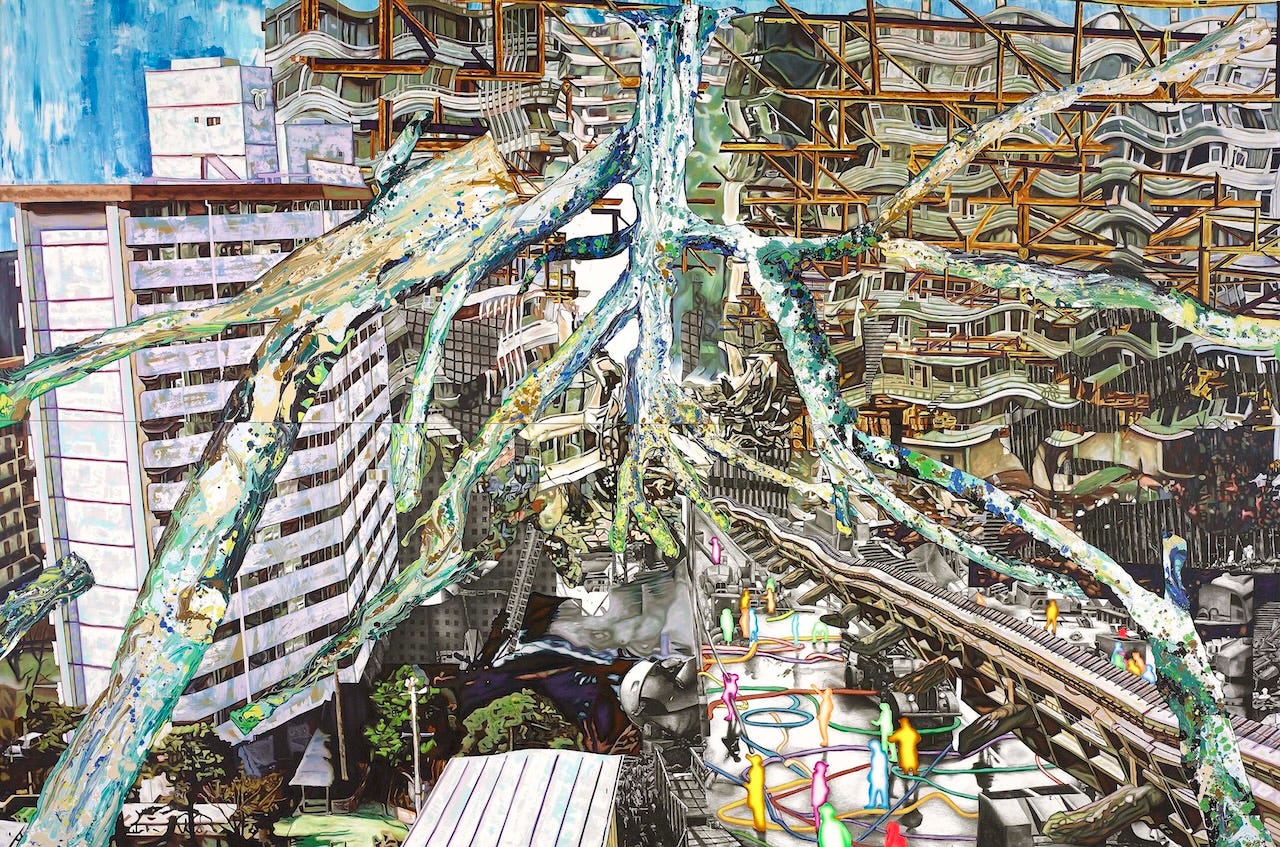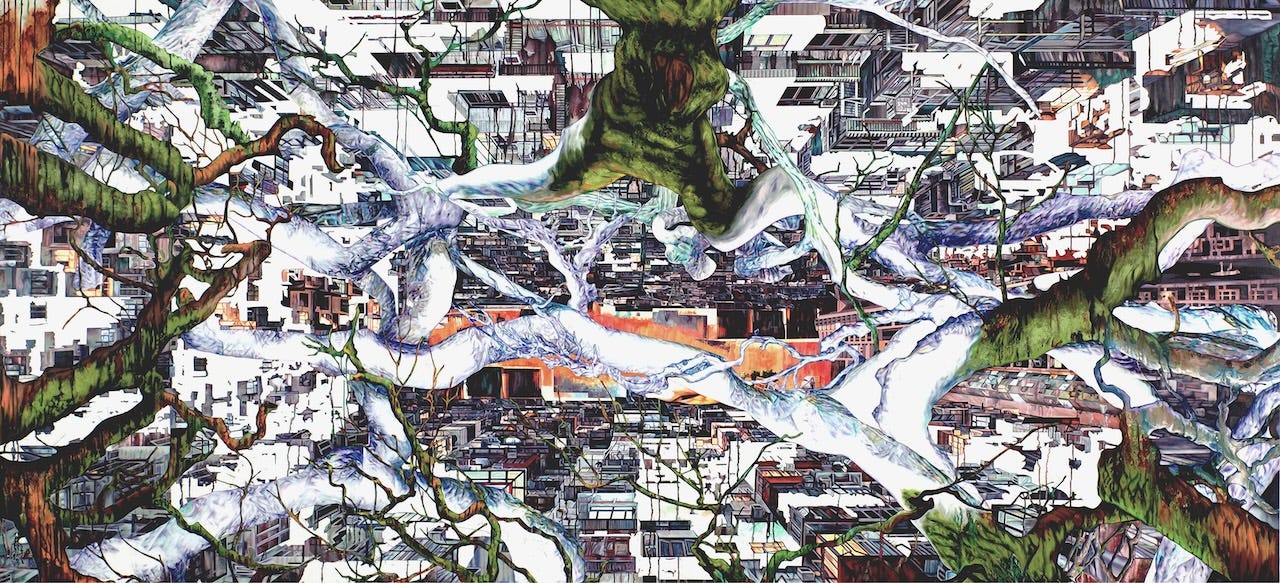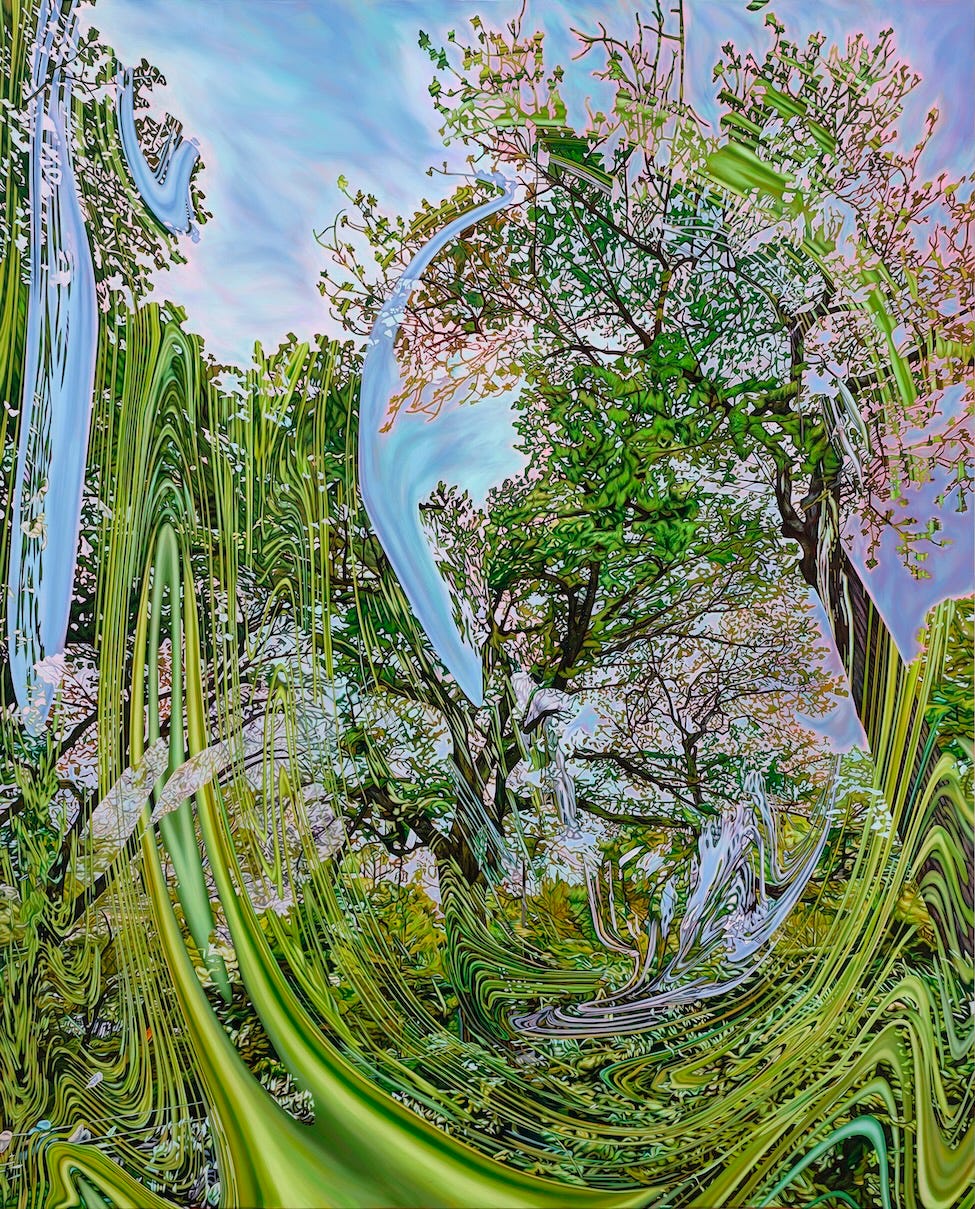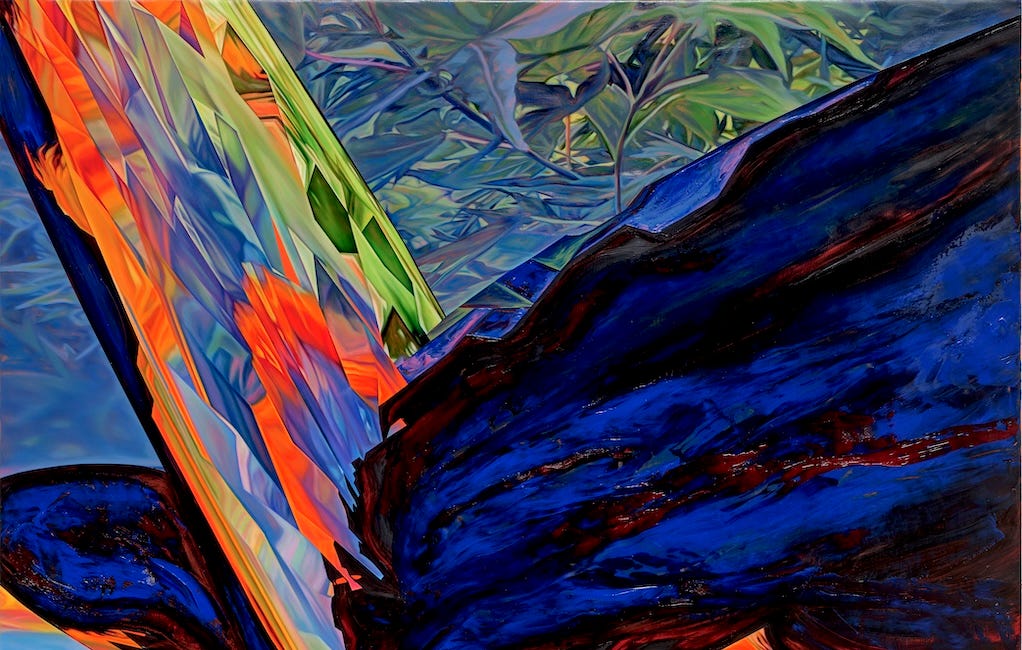Lives of the Artists: Jin Meyerson (Part II)
Fresh off his Perrotin LA show, the painter says that family is a cultural fabric that stretches further than we think
Lives of the Artists is a regular monthly interview column profiling contemporary artists, asking them to share the connections between their home lives and studio practices.
This is the second half of a conversation with the Seoul-based painter Jin Meyerson, who just opened his solo exhibition “Safe Space” at Perrotin in LA. We resume the conversation with his time in New York as an upcoming artist looking to make an impact on the discourse and then move to how his work shifted in Hong Kong and Seoul, taking in the span of his family history, and conclude with a discussion of his life as an artist-parent.
For this portion of the conversation I’ve included works from different periods of his career, focusing on paintings that involve trees, a motif that Jin returns to repeatedly to find new angles, new directions—new branches. I enjoy seeing how the same motif can be put to very different purposes at different moments in the same practice, and particularly enjoy the final image here, titled after this younger daughter.
Let’s pick up back in the early moments of your career in New York. You were talking about how at the outset you didn’t want to bring too much of yourself into the work—you were trying to say something about the culture around you.
Jin Meyerson: The idea of doing autofiction in that moment seemed twee and insignificant and exclusive. Along with friends like Luis Gispert and Jeff Sonhouse, we wanted to engage with the idea of sampling as an advancement from appropriation. Identity was undeniable and context was a given. Then when I moved to Paris a lot of things shifted. I was always in love with history painting, plus the large scale of Rauschenberg and Rosenquist, and in Paris I got more distance from the subject. Jasper Sharp said that I started to dial back the microscope so you could see the whole picture. And then at some point I had built up to a level where the only new territory was to turn it around and focus it on myself. That happened when I moved to Asia, something Freudian about that, first to Seoul for a couple years and then to Hong Kong. In Hong Kong I was also going through a personal crisis. My marriage was collapsing and I was transitioning into single fatherhood. There was a moment where I felt I had exhausted the algorithm. Also because of the technology—we started becoming the curators of our own lives with these new cameras in our phones.
That was all happening at once. At the close of that cycle I stopped painting for a couple years, then had an invitation back to Seoul and did the exhibitions with Hakgojae. Being a single dad really saved me and kept me afloat, because I had something to focus on. And then the fateful, profound meeting with Sunil—it was through her that I started to find community in Korea, both as an artist and in deeply personal ways. My relationship with Sunil provided something that very, very few adoptees ever get, and that is a Korean family and a real place within Korea. There have been a lot of moments in my career when I have no idea what I’m doing, and that’s the advantage of being someone centered on painting, because you need that in order to figure things out on the canvas. You need that unknowing. It’s the concept of the fog of war: you have limited visibility until you get to that part of the map.
You’re opening a solo exhibition at Perrotin in LA this month, which means you’ve probably just finished a cycle of intense studio time. What does your time in the studio look like? The writer, Lauren Groff, has said she will decline to answer the question of how she balances work and family until male writers are asked the question. So our contribution to the discourse is to ask you, as a male painter: How do you balance painting and family?
During undergrad I studied with Elizabeth Erickson, who asked at one point, if you have a choice between having a good family or a good career as an artist, which will you choose? I said I was going to have both. And, even though it has not always been smooth sailing, I have managed to have both. My day-to-day schedule is in service to my family first and foremost. I can’t say that I’ve always been a wonderful father, but I can say that I have always made time and put my family first and then fit the work schedules around that. There are days when I get up unreasonably early to go to the studio and come back to help get our daughter, Pearl, get ready. I have two daughters, two amazing, beautiful creatures. My oldest, Blue, is at boarding school in the States. She’s extremely stable and generous and empathetic, which I really can’t take any credit for. Our youngest, Pearl, is five, and she’s at the age where she needs a lot of attention and oversight. My wife Sunil travels, she is a Partner at Esther Schipper and just got back from Basel and London. I’m very experienced at the single dad thing.
I get into the studio around 9:30 or 10:00, go to the gym around 4:00, get home at 5:30. We have Sunil’s parents, who are an amazing support system. They feed Pearl her first dinner, and then she comes home, I do homework with her, cook her a second dinner, and give her a bath. I read her a bedtime story, then Sunil comes in and gets her to sleep. And that’s basically, you know, the daily schedule. I have become much more efficient with the time I have in the studio. In six or eight hours I can distill the effort of what would have taken me twelve or fourteen hours in my early years. I’m also able to think about the work in terms of its meaning, placement, context outside of the studio. I’ll take photos of what I’m working on and then check in on it on my phone a couple times before I head to bed, and then I know with some clarity what I’m going to be working on when I’m back in the studio in the morning. I’ve been painting for close to 40 years, and through the different cycles of my work I’ve built a rudder, a sense of direction.
Your partner is a brilliant and very successful art dealer. Your first wife was also a high-powered figure in the art world. How do you balance collaboration and independence in your work and personal lives?
There is definitely something there in having grown up with my grandmother and my mother, who were both bank presidents. None of us were in the positions of success or positivity that we are now when we met, and we have been able to build towards these things together. A lot of what I’ve learned to do at home is to be part of a support team. There can be so much pressure in a relationship, and it’s easy to become oppositional with someone that you’re living with and doing projects with because there are so many points of intersection. I do learn from what happens, we internalize and improve. We have a lot of conversations about logistics, navigating how we can support each other in our careers and in our lives. I had some good artist friends but I didn’t really have a Korean art community until I met Sunil, and she unlocked a lot of that for me. I never lose sight of that.
Part of being a member of any community is being in that space with a sense of humility and gratitude. And it’s always been very important to me to give something back. We do have conversations about art and meaning, but a lot of the conversations are also introducing people to each other. Jaeho, the director of the gallery I work with, Johyun, is close with Sunil. Generally artists’ wives in Korea are the ones who handle the business, and Sunil has been very generous in taking on things like taxes and registrations for the studio. And then as someone who wants to support her, I introduce her to my global network and help with translation and content. Being able to build a life and a family together, with this overlay of cultural heritage, is one of the most generous gifts I’ve ever experienced. We don’t always agree, but we really do look after each other.
Looking back on your experience with Blue and now with Pearl, how would you describe your philosophy of parenting?
After I ended up in foster care, I saw a therapist for the first time, and he handed me a copy of Kahlil Gibran’s The Prophet. There’s a lot of stuff on parenting and the parent-child dynamic, quite tender, very intimate ideas that really guided me. I hung onto that. I’m a reactive parent in that I had such a broken relationship with both sets of my parents, so I set out to avoid doing everything that I experienced in my childhood. When we are missing something, like my missing connection to my birth parents or the missing connection to my adopted parents during the crisis period we had, you become hyper-aware of the idea of a meta-family. Having the opportunity to have a family of my own has very much been defined by those two points of loss.
As a single dad with Blue, I know I gave her way too much screen time. It was hard for me because I still hadn’t figured out how to deal with my own internal conversations, make heavily detailed paintings, and be able to curate supervision all at once. We also had the advantage of having a fantastic live-in nanny, Mildred, in Hong Kong and for a year in Seoul. Core values were the most important conversations I had with Blue. If I can take any credit for the person that she’s emerged into, it’s that her core values follow the conversations that we had: about taking a moment to experience sonder, the idea that everyone that you encounter has as much of a narrative, as much internalized exhilaration and trauma as you do. Being in Asia we were able to develop our sense of community, sense of excellence and competition through some great programs that my dad supported Blue and me in. And the ways that we interact socially, in cultivating deep friendships and balancing self-protection with generosity.
With Pearl I have a fantastic copilot, and I default to her on a lot of it. Not only that, we have Sunil’s parents, so there’s generational care. It’s a totally different experience of parenting. I fit in where I can be helpful. At the beginning there were a couple of moments of conflict, because I was so used to controlling everything as a single dad until I figured out I could loosen that grip a little now. Blue grew up in the studio, because there was no other option. Pearl has only been to the studio half a dozen times. Blue will probably never want to be an artist, because she was forced to go to the galleries and the fairs and be my sidekick. Pearl has been able to have a more normal domestic life, though of course all kids have a fantastic fascination with the visual. It’s wonderful to see on the second time through, because I missed so much the first time around.
This is the second part of a two-part conversation. The first part is here:
Lives of the Artists: Jin Meyerson (Part I)
I’ve moved Nostos over to Substack. If you were already subscribed you’ve been moved over automatically. Thanks for being here and thanks for sharing.







